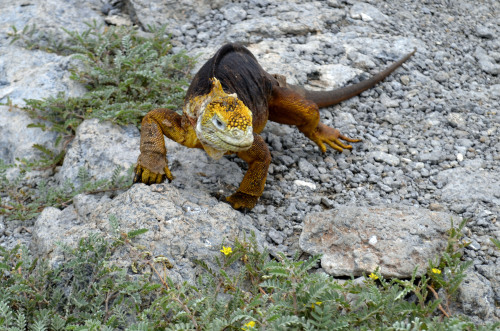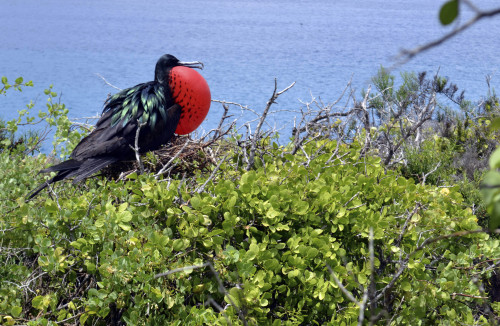SANTA CRUZ, Galapagos Islands (AP) ― The sea lion nursed her pup under a prickly pear cactus while an iguana clumsily marched away. A tiny penguin waddled on a rock as red and orange crabs clung to the craggy surface below.
Welcome to the Galapagos Islands, a volcanic archipelago that inspired Charles Darwin’s theories of evolution and natural selection after he landed here in 1835 on the HMS Beagle.
The remote islands draw an estimated 100,000 visitors a year eager for a glimpse of the unique creatures and flora that Darwin called “a little world within itself.”
Darwin’s theories, developed years after his voyage and discussed in “On the Origin of Species,” stemmed in large part from his observation that the giant tortoises, iguanas, finches and other wildlife and plants on the remote islands were unique and even varied from island to island. He realized that the species must have originated somewhere, and they must have developed new characteristics over time to survive on the uninviting land masses.
Welcome to the Galapagos Islands, a volcanic archipelago that inspired Charles Darwin’s theories of evolution and natural selection after he landed here in 1835 on the HMS Beagle.
The remote islands draw an estimated 100,000 visitors a year eager for a glimpse of the unique creatures and flora that Darwin called “a little world within itself.”
Darwin’s theories, developed years after his voyage and discussed in “On the Origin of Species,” stemmed in large part from his observation that the giant tortoises, iguanas, finches and other wildlife and plants on the remote islands were unique and even varied from island to island. He realized that the species must have originated somewhere, and they must have developed new characteristics over time to survive on the uninviting land masses.

Today after centuries of human contact, the animals and birds that inspired the British naturalist with their ability to adapt are in need of help. A thriving tourism industry, development, overfishing and poachers have taken a toll.
Conservationists, volunteers and trained guides are working to repair the fragile tropical ecosystem, which is spread along the equator more than 965 kilometers west of continental Ecuador. Their efforts started relatively recently and they must balance protecting the islands with the income tourism provides for the largely impoverished human population of some 30,000.
Getting to the Galapagos is surprisingly simple, with regular flights from the Ecuadorean cities of Quito and Guayaquil. Then visitors are usually bused to a ferry or cruise ship. Authorized guides are required for shore excursions, and the number of passengers and boat trips is strictly regulated.
A visit to the Charles Darwin Foundation, established on the main populated island of Santa Cruz in 1959 to spearhead preservation, was the perfect start to a five-day tour of the islands. I booked my trip with the Florida-based Latin America Reservation Center, which made all hotel and transportation arrangements and provided a detailed itinerary of island visits.
The foundation is in the Galapagos National Park, which is home to numerous rescued animals, including a tortoise that was once a pet and had holes in its shell, apparently from being used for target practice.
A tortoise conservation program began in 1965 after the reptiles, which can live for more than 200 years and weigh up to 295 kilograms, were threatened by rats and other invasive species introduced by settlers and ships. Pirates and whalers also collected them, stacking them on board for fresh meat because they can live for months without food or water.
Now, tortoise eggs are collected, incubated and carefully monitored at the park. Each baby tortoise gets a number on its shell so it can be repatriated eventually on the proper island. They are kept in captivity until their shells are hard enough to defend against predators.
Such micromanagement has its limits. Witness the sole survivor of the Pinta Island tortoises, known as Lonesome George, who was found in 1971 and taken to the national park for protection. Scientists have been trying to breed him for two decades, putting two potential girlfriends in his shrub-filled pen, but so far the nearly 100-year-old tortoise has failed to produce any offspring.
Matchmakers decided the ladies were from the wrong island and introduced him in January to two new female partners from the island of Espanola that they hope are closer genetically and more compatible.
The United Nations cited progress when it removed the Galapagos, which comprises 19 main islands and a marine reserve, from its list of endangered World Heritage sites in 2010.
Visitors have two main options: a cruise that allows the tourist to live on the boats and see farther-flung islands, or a hotel stay with guided day trips to nearby islands.
Carolina Pedersen, 31, from Sweden, chose the hotel-day trip combination, staying, as I did, at the Hotel Silberstein, near the main drag in the tourist hub of Puerto Ayora.
“I wanted to go out, having a meal in a nice, cozy restaurant, feel free to do what I want and feel the ground under my feet,” she said. “All day excursions I made were special moments for me ... but my favorite moments were those when I walked down to the port in the evening, looking out at the water, watching all the animals around me, just breathing fresh Galapagos air, and enjoying every second of it.”
Our first day trip began after breakfast with a 45-minute bus ride to the dock, then a dinghy ride to the yacht that took us to various islands each day.
We laid on the sun deck for the hour long ride to North Seymour island. Huge, crystal clear waves crashed against the shore as the dinghy landed.

North Seymour is home to one of the largest populations of frigate birds, which often seemed to dive right at tourists furiously snapping pictures. The birds are known as the pirates of the archipelago because of their skill in stealing food from other seabirds. Males are easily spotted by red throat pouches that inflate so much during mating season they look as if they might pop.
Grasshoppers jumped into our path as we picked our way over loose rocks under strict orders to stay within the markers to protect the breeding grounds. The birds and other animals were remarkably fearless, which made for great photography since we could get so close to them. The smell of salt water mingled with bird droppings.
As we rode away, we saw blue-footed boobies on a cliff. Unfortunately we did not get to witness their famous mating ritual in which males lift their turquoise feet high, then dance to impress the females.
We ate a delicious meal of grilled fish while sailing to Las Bachas, a white sand beach on the southwestern side of Santa Cruz known as a nesting site for the Pacific green sea turtle. Relentless sand flies and a downpour (January-May is rainy season) cut short our visit.
The next day, manta rays leapt out of the water during our hourlong trip to South Plaza Island. A large male sea lion blocked the path on the landing dock carved out of the rocks. The guide explained we had stumbled into a sea lion kindergarten. The male was guarding the young, which scampered in the water and around craggy rocks, while the rest of the colony was out foraging for food.
Land iguanas also greeted us, and a sea gull stood as still as a statue while I took its picture from just a few feet away. We hiked along the cliffs and admired the flora, the masked boobies, so called because of the gray that stretches across their eyes, red-billed tropic birds and others.
We ended up at a cliff covered with some bones ― apparently the remains of a sea lion, although the guide joked that they were the remains of a New York tourist who had been left behind.
As we marched back to shore, lizards darted from the side and we had to veer around the occasional iguana while trying to stay on the marked path and avoid the guide’s wrath.
We took the dinghy back to the boat for lunch while it stormed. When the rain stopped, we had reached a place where we could snorkel, so we jumped into the water from the dinghy, then swam back to the yacht alongside sea lions and flounders. A school of rainbow mackerel swam underneath, and I was excited to see a whitetip shark sleeping in the sand.
The last day began at 6 a.m. for a two-hour boat ride to Bartolome Island, where haunting land scenes for the 2003 Russell Crowe film “Master and Commander” were filmed.
If You Go...
•Galapagos: Visitor numbers are limited and access is regulated, so a packaged tour or cruise is a must. Rates vary depending on time of year, length of stay and type of accommodations. Ecuador’s official tourist site - Ecuador.travel ― offers basic information and sample pricing at http://bit.ly/pKrDqK. One website for U.S.-based tour operators is http://www.discovergalapagos.com.
•Getting there: Fly from Quito or Guayaquil, Ecuador, to the Galapagos islands of Baltra or San Cristobal. A $100 per-person fee ($50 for children) is required at the airport for access to the Galapagos National Park, http://www.galapagospark.org/.
•Charles Darwin Foundation: http://www.darwinfoundation.org/english/pages/index.php



















![[Today’s K-pop] BTS pop-up event to come to Seoul](http://res.heraldm.com/phpwas/restmb_idxmake.php?idx=642&simg=/content/image/2024/04/17/20240417050734_0.jpg&u=)